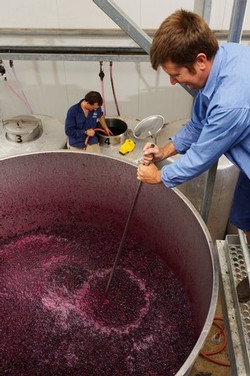How Can Wine Taste Like Other Fruits?
How Can Wine Taste Like Other Fruits?
Have you ever been to a winery, looked at the tasting notes and wondered if you’d stepped into your local fruit & veggie shop by mistake?
Where do flavours of grapefruit, peach, rockmelon, lime, tobacco and dark chocolate come from? Does the winemaker squeeze the juice out of all this fruit and add it to the wine?
Good question. We get asked this a lot at Cellar Door.
Without you having to dust off your high school science textbooks, here’s a pretty simple way to explain what happens …
Grapes themselves have flavours that may remind you of other tastes or smells.
During the winemaking process, the grape juice undergoes fermentation,when the winemaker turns grape juice into
 wine. What happens is the winemaker adds yeast. This converts the sugars in grape juice into alcohol. The fermentation process unlocks chemical compounds that are shared by other fruits and foods which we recognise.
wine. What happens is the winemaker adds yeast. This converts the sugars in grape juice into alcohol. The fermentation process unlocks chemical compounds that are shared by other fruits and foods which we recognise.
There are dozens if not hundreds of chemical compounds that can be found in wine, and if you start mixing and matching them, you get ever more complex flavours and aromas.
Oak barrels also add flavours like spice, caramel, toast and cedar when wines are aged or fermented in them.
Over the years, wine buffs have developed a language for talking about wine, which includes describing the flavours and aromas that a wine reminds them of.
This is not unique to wine: beer nerds, Scotch whisky lovers and coffee connoisseurs are also jumping on the bandwagon and using some pretty amazing descriptors to describe the aroma, taste and flavour of their beverages.
So, let’s have a look at the difference between aroma, taste and flavour as there are subtle differences between them.
Aroma - An aroma refers to an actual chemical compound with a specific scent that can be identified by smelling.
Strawberries, coffee and bacon all have a specific chemical compound that allows us to identify them solely by their smell.
Taste –Only your tongue only can sense taste and feel texture, it can identify:
- sweetness,
- sourness,
- bitterness
- saltiness.
In addition, it can feel heat from alcohol, astringency from tannin and creaminess from milk.
Flavour – This is where the brain’s association between what it smells through the nose, tastes with the tongue and feels in the mouth takes place.
For example, the flavour of strawberry is the brain’s association between a specific aromatic compound; a sweet and sour taste; and a specific tactile sensation of the strawberry being chewed.
The best place to learn more about the characteristics of wine and make the association between the sensations you can smell and taste is to come along to one of our super-popular ‘Wine 101’ Wine Appreciation classes.
Here you can taste a range of Upper Reach wines and match the flavours with fruit, nuts, herbs etc. After the class you’ll be tasting like a pro!